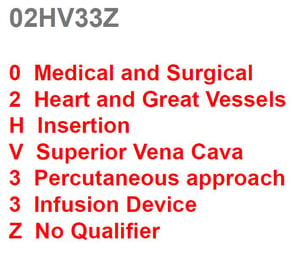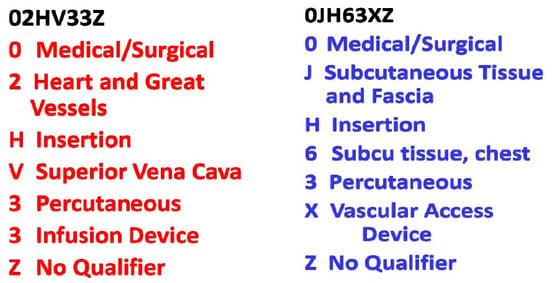12. Vascular Access Devices
The problem is that there are several types of vascular access devices that are coded differently in ICD-10. Official advice has been conflicting and incomplete in how to code each type.
Coding Clinic 4Q 2015 pages 30-32; 2Q2016 p. 15, they state that different types of VADs require different types of ICD-10- PCS codes. PICC, CVC, implanted port, etc. can be coded differently depending on the type. Official guidelines state to code to the “end” point of the catheter, not the entry point of the catheter for central lines and to code fluoro and U/S if utilized for guidance (B51).
The confusing advice is regarding approaches for insertion of port devices. They state “percutaneous” is correct at one point. However, later in the article, they state “open” approach could be used for totally implanted port. This issue was resolved with publication of Coding Clinic 2Q2017 pages 25-26.
Coding Clinic 2Q2015 page 33 updates Coding Clinic 4Q2013 pages 116-117 and supports that “open” be used for TOTALLY implantable ports.
VAD through right subclavian to SVC sutured at insertion site by right subclavian vein: 02HV33Z:
13. Tunneled Hemodialysis Catheter
There has been a lot of confusion on this one. In fact, we sent a letter to AHA Coding Clinic for official advice. They responded and also published the official guidance in Coding Clinic 2Q2017 pages 25.26.
Why the confusion? Part of it is because this is not a totally implanted port. Therefore, two codes are needed when coding for Tunneled Hemodialysis Catheter.
Yes, the catheter is tunneled under the skin – but there are two parts (ports) outside of the body accessed for things like hemodialysis, etc. They are then capped when not in use.
According to Coding Clinic 2Q 2016 pages 15-16, there are two codes assigned: one for vascular catheter to SVC or atrium, and one for tunneled device in subcutaneous tissue.
AHA has answered our letter and advised that a tunneled catheter is coded with two codes, one for the catheter inserted into the vein and threaded to the SVC and another code for the tunneling of the catheter tubing, exiting externally. See example below:
The information contained in this coding advice is valid at the time of posting. Readers are encouraged to research subsequent official guidance in the areas associated with the topic as they can change rapidly.







